Part 4 Credit
@Tarun
(k) Engine-

1500 HP with the option of Manual Override by the Crew and Alternate Starting Mode. The life of the Engine (without overhaul) should not be less than 1000 hours.
(l) Tracks-

Quick-Fit and Detachable Rubberised Pads, incorporating a Dynamic And Automatic Track Tension Measurement and Adjustment System.
(m) Braking System-
Regenerative Braking System.

Special Equipment
(o) It should have a facility for aligning the tank for negotiating a Bridge Layer Tank Railway Wagon/ Tank Transporter.The tank should have Self-Extrication Capability.
(7) Communication:
(a) Radio Communication-
Software Defined Radio. It should be integrated with the Inter-Crew Communication System and other Electronic Systems installed in the tank.
(b) External Communication and Inter Communication:
(i) External Communication. The facility to communicate with other stations on the external radio network should be available to all crew members.
(ii) Internal Communication. A digital Crew Inter-Communication System for all the crew members. There should be external sockets to enable communication with a person located outside the tank.
(c) Remote Communication-
The Commander should be able to communicate remotely with all outstations as well as on the Internal Communication while away from his tank up to a distance of 25m.
(8) Other Capabilities:
(a) Battlefield Management System-
To include an advanced Identification-Friend-or-Foe system. The Situation Awareness Data obtained from the Tactical Information Systems shall be displayed on a Geographic Information System, Military Grade based touch panel, located inside the Future Ready Combat Vehicle.


(b) Navigation-Navigation-
The Hybrid Navigation System, retaining the capability for incorporating satellite (Indian Regional Navigation Satellite System) and Inertial Navigation as and when it is Operationalized.
(c) Ergonomics & Crew Comfort-

(i) Improved Tank Helmets, incorporating Built-In Noise-Cancelling Headphones and Enabling Hands-Free Communication.
(ii) A 1500 Viewing Arc for the Driver while driving closed down. There should also be a provision for rear and side view display inside the driver compartment.
(iii) Provision for storing potable water at a scale of 20 litres per day per crew member and vehicle for 72 hours.
(iv) There should be a provision forEmergency Escape for the Crew in the Tank.
(v) There should be a provision of Individual Underwater Breathing Apparatus (IUWBA) for all Crew Members for Survivability during Deep Fording.
(d) Environment Control Unit-
With Minimum Temperature to be maintained at 25°± 05°C at Ambient Temperature 45°±5°C.
(e) Auxiliary Power Unit-
To operate Specified Systems (FCS, Viewing Devices, GCE, Communication Systems, Battlefield Management System, Navigation System, and Battery Charging) for up to Six Hours continuously with the Main Engine Off.
(f) Stowage-
The Future Ready Combat Vehicle should have suitable ruggedized containers and arrangements for the logistic needs of the crew so that they can be Self-Contained for 96 hours.
(g) Mil Std All electrical and electro-mechanical systems/sub systems/assemblies of Future Ready Combat Vehicle shall comply with latest version of EMI/EMC Test Standard 861 as applicable at the time of issue of RFP.
(9) Operation and Maintenance:

(a) Family of Technical Support Vehicles:
(i) Minimum two workshop-level Technical Support Vehicle, one as Workshop Repair Lorry (Chassis and Automotive, Armament, Electrical any other facilities) and second as Guided Weapon System and Communication System Repair Lorry (Missiles and Communication Requirements), based on the systems that can be diagnosed and repaired/replaced in Battle Conditions.
(ii) The Vehicle Platform should be in Service 8 x 8 Vehicle.
(b) Built-In Test Facility:
(i) The Future Ready Combat Vehicle should have an ‘On-board Monitoring and Diagnostic system’ which will be receiving inputs from sensors of various systems fitted in the tank and provide real time information on digital display regarding status of serviceability of the system.
(ii) Each system should incorporate a built-in diagnostic and test facility and will be displayed on the information unit of the commander. Driver will have a separate display system for systems related to Engine, Transmission, and Running Gear.
(c) Mil Std-
All electrical and electronic system/sub-systems/assemblies of Future Ready Combat Vehicle shall comply with latest version of JSS: 55555 (or the latest standard/ protocol in vogue).as applicable at the time of issue of Request for Proposal. Other components shall be of Military-Grade Standards to ensure the Reliability and Ruggedisation of the components.
(d) Reliability:
(i) All systems and sub-systems, including ammunition, should be capable of operating between minus 30° and plus 50° C ambient temperature to include HAA areas.
(ii) The assemblies/sub-assemblies of all systems of Future Ready Combat Vehicle should have very high Mission Reliability and very high Mean Time Between Failures /Mean Time To Repair.
(e) Maintainability:
(i) The Future Ready Combat Vehicle should incorporate modular systems to enable quick replacement and repairs at Field Workshop level.
(ii) All sub-systems of the Future Ready Combat Vehicle should have high Mean Time Between Failures and low Mean Time Taken to Repair.
(f) Technical Literature/User Handbooks-
All the requisite technical literature and user handbooks, in bilingual form, should be provided along with the tank.
(g) Training Aids-
(i) Containerised Advance Training Simulators for Driving, Gunnery and Crew Integration.
(ii) Section-ised/ Working models, Technical Charts and Blow-Up Diagrams.
(iii) Computer Based Trainer packages.
(iv) Tactical-Cum-Firing Training system which can be integrated into the tank FCS.
(h) Driver Information System-
(i) A processor unit which will display vital performance parameters of engine and transmission unit. Based on the parameters, the processor should also display messages related to periodical maintenance tasks and have facilities to enter the date of carrying out the tasks for retrieval of information at later point of time.
(ii) Software being used in any of the systems/simulators must be developed as per procedure stipulated in IEEE 12207 or mutually agreed procedure which is better. The quality model used by the manufacturer/developer of software should be ISO/IEC 25010:2015 or better.
(10) Initial and Recurring Requirement:
(a) Prototypes-
03 tanks for user trials.
(b) Series Production-
Not less than 150 tanks per year
SOME KEY POINTS:
(a) Tank Urban Survival Kit (TUSK)-

The crew should be able to fit TUSK within Six Hours in Field. The sides and belly should have protection from CE weapons and IEDs of up to 25kg of TNT.
(b) Shooting Sensing-
Provision to incorporate Shooting Sensing Technology to sense the direction of firing by an Anti-Tank Weapon System.
(d) Stealth Technologies-

Stealth and Signature Management Technologies
as part of Survivability Measures, as and when
developed.
(e) Mobility-
(1) Active Suspension–
Active Suspension for sensing the terrain and providing a fully stable firing platform during move.
(2) Codificationand Standardisation
(i) All items of Future Ready Combat Vehicle down to component level must be codified with Bar Coded Identification.
(ii) In case of indigenous manufacture, the items shall be codified from the directorate of standardisation at the time of supply of Future Ready Combat Vehicle and part numbers mentioned in technical documents.
KEY CHARACTERISTICS OF SOME DESIRED SYSTEMS:

(a) Intelligent Power Management System to provide Distributed Power.
(b) Modular, Variable HP, intelligent engine with Minimum 1500 HP.
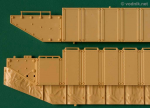
(c) Light Weight, High Hardness Composite Material for Passive Armour
These are what Indian Army wants in their new future armoured platform.
What do you think about this? Write in the comment section.
 FRCV – A Complete Details
FRCV – A Complete Details

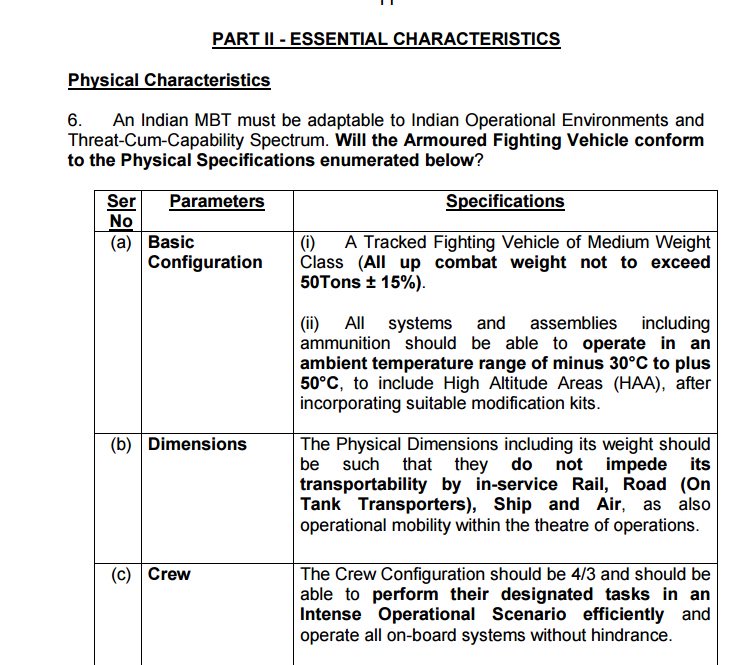
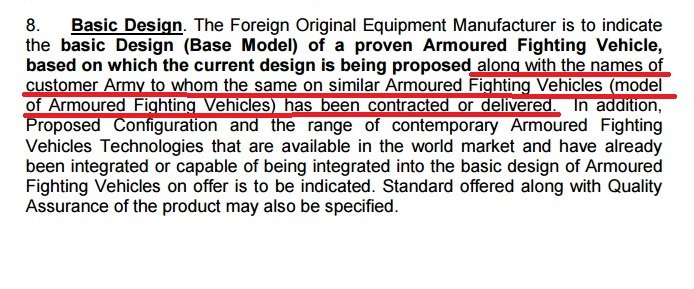

















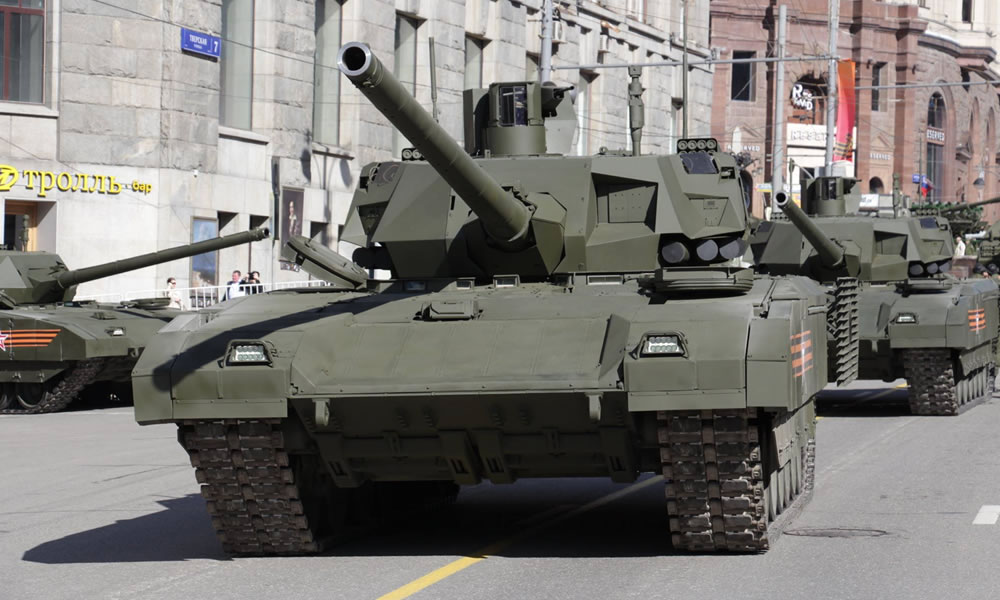













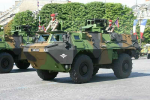









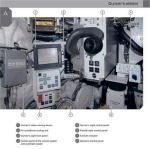










 Special Equipment
Special Equipment








